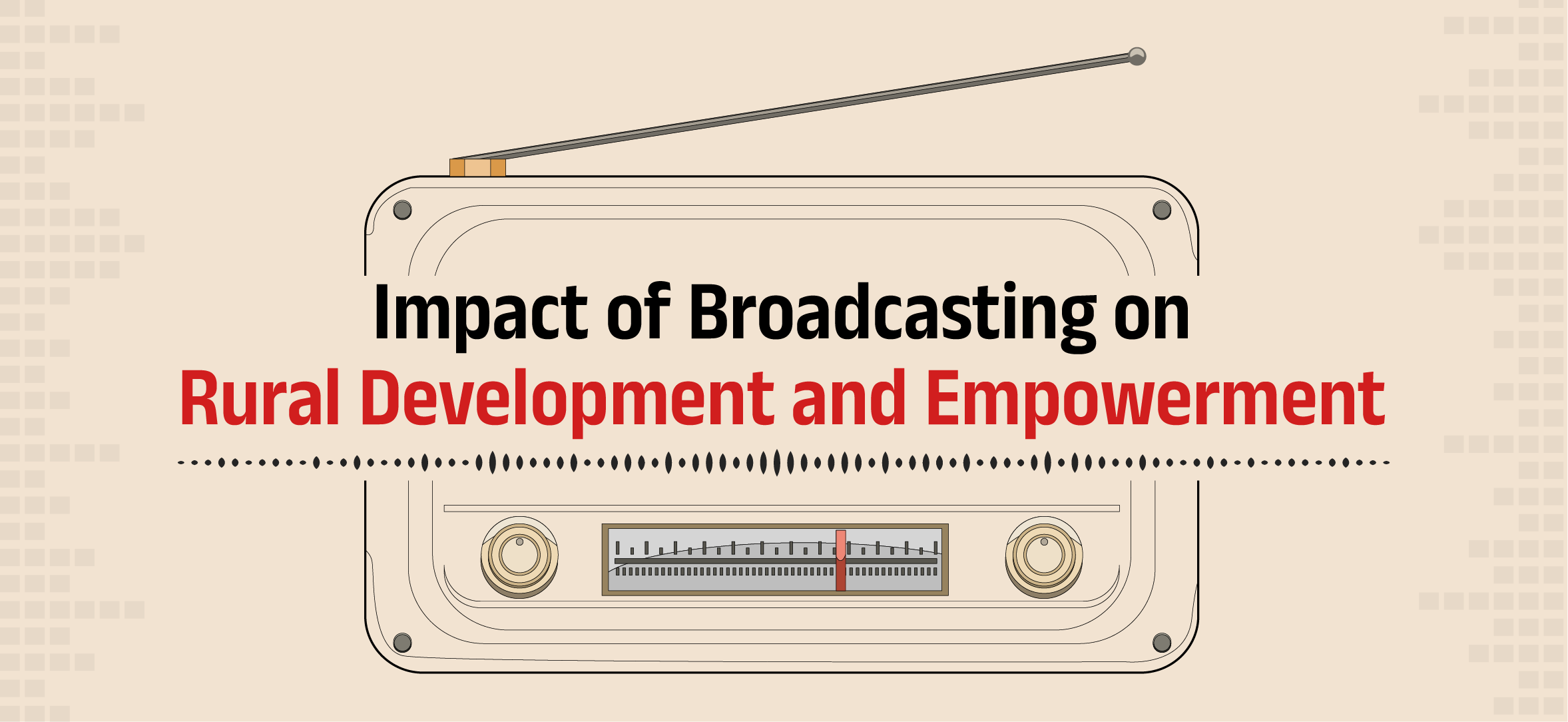Impact of Broadcasting on Rural Development and Empowerment
Blogs Home
- 21 Jul 2023

The systematic distribution of amusement, information, instructional programming, and other characteristics for simultaneous receiving by a dispersed audience with suitable receiving equipment is referred to as broadcasting. The term "broadcast media" refers to various media used for broadcasting, transmitting, and connecting with the general audience. It makes use of a variety of electronic or electromagnetic mediums, as well as audio-visual materials, to transmit news, information, entertainment, advertisements, etc. to the target audiences or the wider population. Television news, audio production, video production, print media production, television and radio programs, etc. are all forms of broadcast media. Through satellite signals, it offers recorded content, digital and written content, or live recording on radio, television, or any other platform.
Every year on July 23rd, India commemorates National Broadcasting Day to recognize the historic occasion of the nation’s first-ever radio broadcast in 1927. On this day in Bombay (now Mumbai), the British Indian Broadcasting Company (BIBC) launched its radio broadcasting service with a 15-minute program of songs and remarks. This incident signified the start of a new age for public communication in India.
Rural Development and Empowerment
Rural development and empowerment are crucial for sustainable and inclusive growth, reducing poverty, and achieving overall social and economic progress in a country. It aims to create an environment where people can lead fulfilling lives, regardless of their geographical location. Although rural communities face a range of challenges and issues that can hinder their development and well-being. Some of the key challenges include limited access to basic services, poverty, and unemployment, lack of infrastructure, health challenges, educational disparities, gender inequality, and limited internet connectivity and digital literacy in rural areas hamper access to information, online education, and modern communication channels. It's important to recognize that the interplay of these factors can be complex and context specific. Effective rural empowerment initiatives often require a holistic approach that takes into account the unique challenges and strengths of each rural community.
Addressing these challenges requires comprehensive rural development strategies that focus on improving infrastructure, providing access to basic services, enhancing agricultural productivity, promoting education and skills training, empowering marginalized groups, and fostering sustainable and inclusive economic growth in rural areas. Collaboration between governments, non-governmental organizations, private sectors, and local communities is essential to tackle these issues effectively.
Governments, NGOs, and other stakeholders play significant roles in implementing policies and programs that foster rural development and empower rural communities. The Ministry of Rural Development and the Government of India, in collaboration with the Departments of Rural Development and Land Resources, has been implementing several plans to improve our nation's rural areas. These programs are designed to help Indians who live in rural areas since they would ultimately support the country's economy in the long term. The Government of India has established many important programs for rural development, including:
- Pradhan Mantri Gram Sadak Yojana (PMGSY)
- Deen Dayal Upadhyaya Grameen Kaushalya Yojana
- Deendayal Antyodaya Yojana/ National Rural Livelihood Mission
- Prime Minister Rural Development Fellows Scheme
- Mahatma Gandhi National Rural Employment Guarantee Act (MGNREGA)
- Sampoorna Grameen Rozgar Yojana (SGRY)
- Samagra Shiksha Abhiyan
- National Social Assistance Programme (NSAP)
- Pradhan Mantri Awaas Yojana (Gramin)/ Indira Awas Yojana
- Antyodaya Anna Yojana (AAY)
- Provision of Urban Amenities in Rural Areas (PURA)
Role of Broadcasting in Rural Development and Empowerment
Broadcasting plays a crucial role in promoting rural development by providing information, education, and entertainment to rural communities. It can have a significant impact on various aspects of rural life, leading to economic, social, and cultural advancements. Broadcasting contributes to rural development promotion in many ways. Broadcasting, especially through radio and television, can reach remote areas and deliver essential news, weather updates, agricultural practices, health and hygiene information, government schemes, market prices, and other vital information that can improve their daily lives and decision-making.
Farmers can be educated about modern farming techniques, crop management practices, irrigation methods, pest control, and the latest research findings, all of which can increase agricultural productivity and income. Rural communities often have rich cultural heritage and traditions that need to be preserved. Broadcasting can play a role in promoting local art, music, and storytelling, strengthening cultural identity, and fostering social cohesion within the community. Through community radio stations and interactive programs, broadcasting can empower rural residents by providing them with a voice and a platform to discuss issues that affect their lives. It encourages community participation, democratic values, and engagement in decision-making processes.
Radio, television, or the internet can broadcast educational content, including formal schooling, adult literacy classes, vocational training, and life skills development, enabling individuals to acquire new skills and improve their employability. Broadcasting can provide rural entrepreneurs and local businesses with a platform to showcase their products and services to a wider audience. It can also promote local tourism, handicrafts, and other economic activities, thus stimulating the local economy.
Raising awareness about health-related issues, preventive measures, family planning, immunization programs, and hygiene practices. It can also connect rural communities to healthcare experts and specialists through interactive shows or telemedicine initiatives.
Overall, broadcasting has the potential to bring about positive social change and accelerate rural development by empowering communities with knowledge, information, and resources necessary for sustainable progress.
Improving broadcasting in rural development can have a significant impact on the dissemination of information, knowledge sharing, and overall development of rural communities. Broadcasting in rural development can become a powerful tool to empower and uplift rural communities, fostering sustainable development and progress by:
- Establishing and supporting community radio stations in rural areas.
- Utilizing mobile technology to deliver broadcast content to rural areas. This could include podcasts, short videos, or audio messages that can be accessed on mobile phones even without internet connectivity.
- Involving local communities in the creation of broadcasting content. Encourage them to share their stories, experiences, and knowledge, making the broadcasts more relatable and valuable.
- Ensuring broadcasting is available in local languages to maximize its reach and impact. People in rural areas may have limited proficiency in official languages, so using local languages will help in better communication.
- Incorporating educational programs into broadcasts to improve literacy, health awareness, agricultural practices, and other essential skills for rural development.
- Providing regular weather updates and agricultural information, such as crop management techniques and market prices, to assist farmers in making informed decisions.
- Collaborating with non-governmental organizations (NGOs) and government agencies that are working on rural development initiatives to share information and amplify their efforts.
- Providing training and capacity-building programs for local broadcasters and content creators to improve the quality and effectiveness of broadcasting in rural areas.
- Leveraging social media platforms to share broadcasting content and engage with a wider audience beyond the immediate reach of the broadcast signals.
- Using broadcasts to promote entrepreneurship and local businesses, encouraging economic growth within the rural communities.
Issues and Challenges
Providing access to broadcasting services in rural areas in India has been an ongoing challenge. However, the Indian government has taken various initiatives to improve connectivity and ensure that broadcasting services reach remote and underserved regions. Here are some of the key measures that have been undertaken:
- Prasar Bharati is India's public broadcasting agency that operates Doordarshan (DD) television channels and All India Radio (AIR) radio stations. The organization has been working to expand its network and increase the coverage of DD and AIR signals in rural areas.
- The Indian government launched the Digital India campaign, which aimed to digitize cable TV services across the country. This move has led to increased digital cable TV services penetration in rural areas, providing access to a broader range of channels.
- DTH services have gained popularity in both urban and rural areas due to their accessibility and the variety of channels they offer. Various private DTH service providers have expanded their reach to rural regions, bringing television content directly to homes via satellite signals.
- Community radio stations have been set up in rural areas to provide localized content and information tailored to the specific needs of the local population. These stations play a crucial role in disseminating information and connecting communities in remote regions.
- The government has been gradually introducing DTT services in select areas to improve TV broadcasting quality and expand the reach of digital TV services to rural communities.
- The Bharat Net project aims to provide broadband connectivity to all gram panchayats (village-level local government bodies) in India. This initiative plays a significant role in bridging the digital divide and facilitating access to online broadcasting services in rural areas.
Despite these efforts, challenges persist in terms of infrastructure development, affordability, and awareness. Remote and hilly terrains can make it difficult to establish reliable broadcasting infrastructure, and economic constraints may limit the adoption of digital broadcasting services in some areas.
Conclusion
In conclusion, I must say that broadcasting channels have had a big impact on our nation's socioeconomic and cultural growth. It functions well as an interpreter in addition to being an informant, educator, and entertainer. These characteristics contribute to the eradication of poverty and illiteracy, the guarantee of work in rural areas, the enhancement of their capacity building and abilities for the comprehensive development of rural India, and the integration of these groups into society.
Sources
https://www.britannica.com/technology/broadcasting
https://rural.nic.in/en/scheme-websites
Arifa Nadeem

Arifa Nadeem is from Jhansi, UP. She has qualified UGC NET in Tourism Administration & Management and is currently pursuing her Ph.D. in Tourism from Bundelkhand University, Jhansi.
Blogs Home



